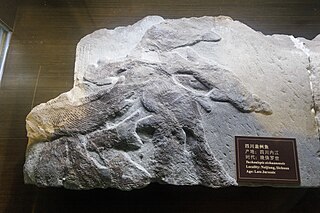
This page features lists of species and organisms that have become extinct. The reasons for extinction range from natural occurrences, such as shifts in the Earth's ecosystem or natural disasters, to human influences on nature by the overuse of natural resources, hunting and destruction of natural habitats.

A piscivore is a carnivorous animal that primarily eats fish. The name piscivore is derived from Latin piscis 'fish', and vorō 'to devour'. Piscivore is equivalent to the Greek-derived word ichthyophage, both of which mean "fish eater". Fish were the diet of early tetrapod evolution ; insectivory came next; then in time, the more terrestrially adapted reptiles and synapsids evolved herbivory.
Cyprinodon longidorsalis, the cachorrito de charco palmal or La Palma pupfish, is a species of fish in the family Cyprinodontidae. It was endemic to the Ojo de Agua la Presa in southwestern Nuevo Leon state in Mexico, but became extinct in the wild in 1994 due to habitat loss. The same freshwater spring system was the home of three other pupfish: Cyprinodon ceciliae (extinct), Cyprinodon inmemoriam (extinct) and Cyprinodon veronicae. Although these were from the same spring system, each was restricted to its own individual spring pool. The Charco La Palma pool and its spring had a combined area of about 10 m2 (110 sq ft) and was no more than 1.4 m at the deepest point, making the range of the La Palma pupfish perhaps the smallest known for any vertebrate species. This tiny spring pond also was the home of a now-extinct, undescribed species of Cambarellus crayfish.

Pachythrissops is an extinct genus of ray-finned fish. It contains two species, P. laevis from the Purbeckian of England and P. propterus from the Tithonian of Germany. A third species, P. vectensis, has been reassigned to the elopiform genus Arratiaelops. Pachythrissops is often regarded as one of the most primitive members of the order Ichthyodectiformes; however, a phylogenetic analysis by Cavin et al. (2013) placed it and the related genus Ascalabothrissops outside the group.
Phyllodus is an extinct genus of bony fish from the Maastrichtian to Middle Miocene. Fossils of the genus have been found in the Maastrichtian to Lancian Hell Creek Formation and the Eocene London Clay.

Saurodon is an extinct genus of ichthyodectiform fish from the Cretaceous.
Thoracopterus is an extinct genus of overwater gliding ray-finned fish from the Carnian age of the Late Triassic. It is a monotypic taxon, with the type species being T. niederristi.
Elopopsis is an extinct genus of prehistoric bony fish that lived from the Cenomanian to Campanian.

Eubiodectes is an extinct genus of prehistoric bony fish that lived during the Cenomanian.
Enischorhynchus is an extinct genus of prehistoric bony fish that lived during the Turonian of southern Texas.
Antofagastaichthys is an extinct genus of ray-finned fish that lived in what is now Chile during the Oxfordian stage of the Late Jurassic epoch. It contains one species, A. mandibularis, which is known from several fragmentary specimens discovered in the El Profeta Formation of Antofagasta Province.
Oligopleurus is an extinct genus of prehistoric bony fish that lived during the Kimmeridgian stage of the Late Jurassic epoch.

Saurostomus is an extinct genus of prehistoric bony fish that lived during the early Toarcian stage of the Early Jurassic epoch.
Pholidophoretes is an extinct genus of prehistoric ray-finned fish that lived during the Carnian stage of the Late Triassic epoch.
Elpistoichthys is an extinct genus of prehistoric bony fish that lived during the Carnian stage of the Late Triassic epoch.

Yuchoulepis is an extinct genus of prehistoric ray-finned fish.

Todiltia is an extinct genus of prehistoric bony fish.

Gyrolepis is an extinct genus of prehistoric ray-finned fish from the Middle-Late Triassic epochs in what is now Europe. It is known both from complete specimens and isolated skeletal elements, such as scales or teeth.

Notelops is an extinct genus of prehistoric ray-finned fish.

The evolution of fish began about 530 million years ago during the Cambrian explosion. It was during this time that the early chordates developed the skull and the vertebral column, leading to the first craniates and vertebrates. The first fish lineages belong to the Agnatha, or jawless fish. Early examples include Haikouichthys. During the late Cambrian, eel-like jawless fish called the conodonts, and small mostly armoured fish known as ostracoderms, first appeared. Most jawless fish are now extinct; but the extant lampreys may approximate ancient pre-jawed fish. Lampreys belong to the Cyclostomata, which includes the extant hagfish, and this group may have split early on from other agnathans.










